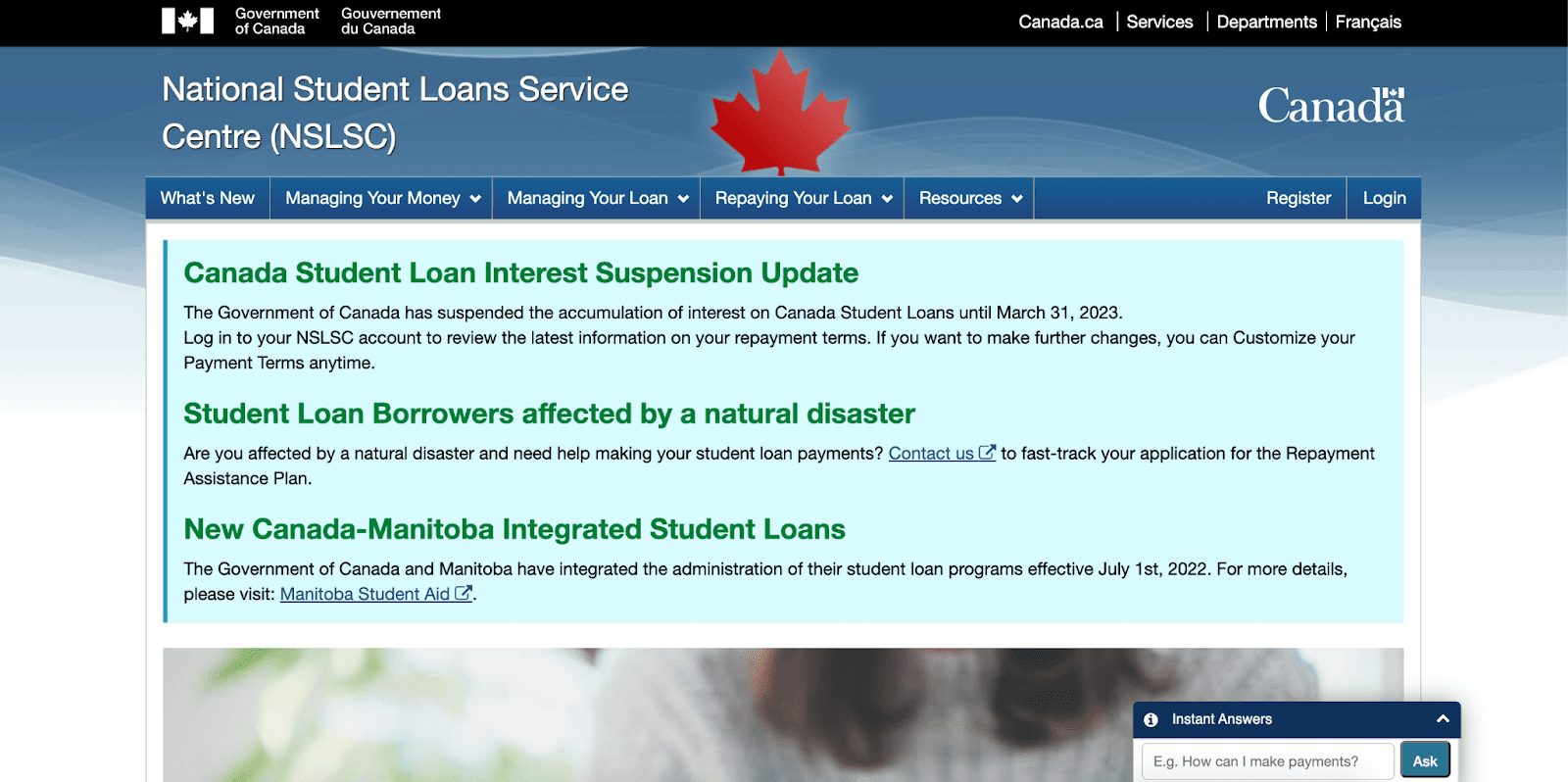How to Get a Student Loan With the National Student Loans Service Centre
By Arthur Dubois | Published on 04 Dec 2022

Students aren’t exactly rolling in cheddar. The National Student Loans Service Centre can help bankroll you to college. Ideally, Canadian students entering post-secondary education would have all the money they need to start and finish their program. However, for many students leaving high school, student loans will be their main or only option.
Luckily, Canadian students can get financial help through the National Student Loans Service Centre (NSLSC). Student loans are administered and disbursed by both federal and provincial governments. However, people in Quebec, Nunavut, and the Northwest Territories need to contact their regional student financial assistance office. These jurisdictions operate their student loan programs, independent of the NSLSC.
Are you stressed about the cost of tuition? Yeet your anxiety with this review. We’re going to explain the National Student Loans Service Centre and how it works. Plus, everything you need to know about applying for student loans.
What information does the National Student Loans Service Centre need?
We’ll be mentioning and explaining all the information you’ll require for this process. This is a quick list for future reference:
- Social Insurance Number
- Access to online banking or a GCKey
- Banking deposit information; a PAD agreement or void cheque from your online banking is perfect
- Financial information: tuition and education costs, and your financial life: income, assets, savings/contributions to your education.
- Information on your living situation
- Information on your enrolment in post-secondary education: tuition costs, books/supplies cost estimates
Read More: How to Write a Cheque in Canada
Navigating the National Student Loans Service Centre website
Everything you will need or could want is located on the Nation Student Loans Service Centre (NSLSC) website. The NSLSC homepage features important notifications at the top of the page. As of this writing, there is info about:
- Suspension
- Those affected by natural disasters
- Changes to the Canada-Manitoba student loans program.
The page’s navigation bar has tabs, such as:
- What’s New
- A language selector for French and English
- A login tab
- Four drop-down menus.
The drop-down menus have information you are looking for to apply, manage, and repay student loans. However, there is a lot of assistance and information found further down the page.

First, you will find links to register and log in to the NSLSC. Second, at the bottom of the page is an “Instant Answers” chat box with the Top 5 Questions. If you cannot quickly find the answer to your questions, “Instant Answers” will connect you to a live chat. This “Instant Answers” box will always be at the bottom of every NSLSC page.
The Learning Hub
On the National Student Loans Service Centre homepage, you’ll see a slideshow with five separate and important links. Links change with what is most relevant and current. Most of the information can be found through the drop-down menus. For example, there is a slide for “Managing Your Money,” which has a separate dropdown menu.

The Learning Hub can be found under the “Resources” drop-down menu. The Learning Hub has a separate submenu to help inform you and manage your loan. Each sub-menu is fine-tuned for the needs of the student.
For example, you will find information about:
- The National Student Loans Service Centre
- General information on credit and loans
- A budgeting tool
Under “Repayment,” you’ll find:
- Loan repayment information
- Banking information
- Support for Young Canadians
Check “Additional Resources” for more info and tools. Bonus points to the NSLSC for having an easy-to-navigate website and a variety of linked, informative YouTube videos for users.
Read More: How to Make a Budget With Hardbacon
Register & login to the National Student Loans Service Centre
To get a student loan from the National Student Loans Service Centre, you must apply for one. To apply for the loan, you’ll need to first register for an NSLSC. Let’s cover all the information that you need to have on hand before applying for a loan. The very first thing you will need is your social insurance number (SIN).
Read More: Social Insurance Number in Canada: Everything You Need to Know
To start the registration process, simply scroll down the home page to the “Register your NSLSC Account” button and click. The next screen will provide information on registering your account and why you need to provide your social insurance number. Again, this is simple: input your social insurance number and click continue.
The next screen provides you with information about the registration process. You have to acknowledge you have read this information by clicking on the “Continue Registration Button.” Then you need to log in via a GCKey or through a Sign-in Partner. This step will be lengthy, about 20 minutes, and direct you from the NSLSC’s site. However, you will be directed back to the NSLSC’s site and registration process when completed.
Your log-in will be used across the Government of Canada’s online services, including the Canada Revenue Agency and Service Canada. There are numerous Sing-in partner options. It’s easier to use one of those rather than the GCKey. The GCKey is better for people who do not have access to a sign-in partner.
Read More: The Ultimate Guide to Student Loans in Canada
Identity verification
Next, you‘ll need to verify you are the account holder by logging in and verifying your SIN and birthdate. Then, you’ll receive a temporary security code via email to continue the process. To access the NSLSC site through a GCKey, you to need to connect those two accounts in a separate step. However, most people have access to online banking. Banks like RBC, Scotiabank, Vancity, and BMO are amongst the sign-in partners available. This is how I access everything on Government of Canada websites. It’s simple and easy.
And that’s it. Now you have an NSLSC account and login information across the Government of Canada’s various websites. Now you have can log in to your account on the home page. Or on the man navigation bar and further down the page, next to the “Register your NSLSC Account” button.
Who’s eligible for National Student Loans?
The National Student Loans Service Centre requires you to be accepted into a valid post-secondary institution. Furthermore, you must:
- Be a citizen, permanent resident, or designated as a protected person
- Be a permanent resident of a province or territory that issues Canada Student Grants and Loans
- Demonstrate financial need.
That is why you have to show all the assets or investments made on your behalf. To qualify for NSLSC funding, full-time students must be enrolled in 60% of a full course load. That means 3 classes at degree-granting institutions or 40% for those with disabilities. Part-time students fall between 20-59% of a full course load. Degrees, diplomas, or certificate programs that run for 12 weeks, across 15 consecutive weeks are eligible for funding. That’s essentially an academic semester.
What schools get National Student Loan funding?
Which institutions are eligible for funding from the National Student Loans Service Centre? A lot in each jurisdiction. That’s the simplest answer to that question. Fortunately, the government of Canada provides an updated master list of all institutions that qualify for funding.
Qualifying institutions include all degree-granting Universities, including technical-degree granting institutions, international universities, and junior colleges. Many private institutions like secular schools and trade schools are also eligible. Click on your jurisdiction and scroll to see if your desired school is available for funding.
Applying for a student loan
Now, we get to the difficult part: applying for a student loan. Don’t be worried, it’s not nearly as difficult as you may fear.
There is a lot of information you’ll need to provide during this process. To find out how much funding you may receive, use the Student Financial Assistance Estimator tool. It allows you to preview the kinds of data you’ll be inputting, which will determine how much you could receive. Also, your application will automatically be assessed to see if you qualify for any Canada Student Grants as well.
Throughout your academic journey, grants, scholarships, and bursaries become more important. They keep the cost of your education low. A grant from the NSLSC is somewhere to start. And you won’t have to do anything extra, unlike other grants and bursaries you’ll apply for.
What is the Master Student Financial Assistance Agreement?
You will be prompted to complete a Master Student Financial Assistance Agreement (MSFAA) during the registration process. If there’s no prompt, you probably already have an MSFAA number. Or you might need to complete the MSFAA by logging into your account.
Your notice of assessment will have your 10-digit MFSAA number on it. This number will also be found on your jurisdiction-specific website. Here, is an example of how to find your MSFAA for students in Ontario. After your application has been assessed, you will be able to find the MSFAA number in your account’s information.
How to Apply
There are five steps to apply. Each takes various amounts of time. The NSLSC advises applying for funding at least two months before commencing studies. Some of this information may be delivered by ground mail. It’s better to apply for funding once you have received your acceptance letter and begun enrolment into post-secondary studies. Depending on your jurisdiction, you’ll have to pursue different options at this point.
To do this, check the NSLSC’s link to the list of provincial and territorial student aid sites. Here, you’ll truly start applying for student loans. Once you have completed the application on the jurisdiction-specific website, your next step is to wait. That’s right, step two in the application process is to wait for your notice of assessment. That‘s when you’ll find out if you qualify for student loans, and how much you qualify.
Read the contract carefully
The next step is to review and accept the MSFAA terms and conditions. The MSFAA is a legally binding contract. Like anything legally binding, read this document carefully. The MSFAA is a multi-year contract. So you only have to complete this step once, even if you have to apply for funding more than once.
At this point, you’ll need to provide your direct deposit information, if you already haven’t. This information can be uploaded and updated immediately after your account has been created. You can change this information at any time through your NSLSC account.
The next step is to either register for an account or to log in and submit your loan documents. Here, you’ll sign your MSFAA and submit it digitally. And, believe it or not, that’s really it!
The next step is to wait for your disbursement to arrive at the beginning of the semester. There will normally be two disbursements per year for students. However, this is entirely dependent on the student’s academic activity. If you are applying for part-time funding for spring or summer classes, then there would be a third (or fourth) disbursement.
Contact the National Student Loans Service Centre
At the bottom of every page, you will find a link to the NSLSC’s Contact Us page. Aside from the quick questions feature and a live chat option, the NSLSC also has:
- Phone numbers
- Email,
- Social media
- Mailing address
- Other contact information on the site
You can appeal a decision about your student loan application, or the loan itself. Appeals must be done through your regional jurisdiction’s website.
A Brief History of The National Student Loans Service Centre
Student Loans in Canada began with the Dominion-Provincial Student Loan Program (DPSLP), in 1939. It wasn’t until 1944 that all of Canada’s then provinces joined the program.
Newfoundland joined Confederation in 1949, and the DPSLP in 1950. Quebec favoured a Provincially-prioritized higher education system, justifying leaving the program in 1954 on constitutional arguments. The DPSLP was discontinued in 1967, having never been highly utilized. It was woefully insufficient to address the increases in post-secondary education students and the cost of attending a post-secondary institution.
The Canada Student Loans Plan (CSLP) of 1964 replaced the DPSLP. It was designed to better address the needs of a growing population of post-secondary students. It guaranteed up to 60% of the required funding to Canadian students who demonstrated financial need.
What about the remaining 40% of students’ education funding requirements? The Province’s determined If and how much funding a student would receive to cover their educational costs.
Today’s CSLP
Escalating costs of education required changes to the CSLP in 1994. The Canada Student Financial Assistance heavily revised the CSLP. It improved accessibility, financial limits for students, and an interest relief program. This is a program that the NSLSC website has information and application options on the site. It is something that every loan holder should be aware of for their post-education financial planning.
The NSLSC is a division of Human Resources and Social (Skills) Development Canada (HRSDC). It was created for federal student loan holders to better manage their loans. Provincial loan holders in British Columbia, Saskatchewan, Manitoba, Ontario, New Brunswick, and Newfoundland and Labrador can manage their provincial loans through the NSLSC. As we will see, the NSLSC is also a central location for a wealth of information on all things student loans in Canada.
